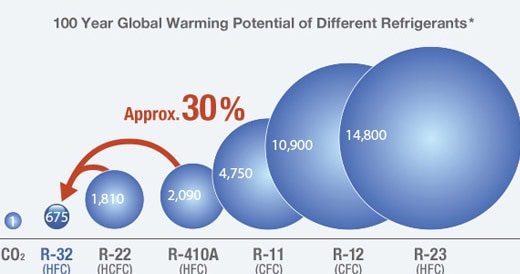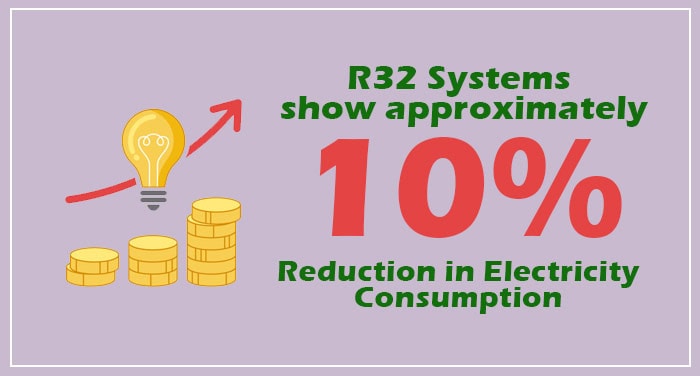One of the most popular R410A replacement is R32. Since its introduction in the market, many manufacturers are shifting their attention towards it. But the question in most people’s minds is (including HVAC technicians): R410A vs R32, which one is better?
The answer: R32 is a better refrigerant than R410A in terms of cooling efficiency, energy efficiency, electricity consumption, performance, cost, and environment friendliness.
If you want an in-depth explanation on this, we plan to discuss this in detail in this article.
Let’s dive into it!
What is R410A and R32?
Generally, both R410A and R32 are HFC (hydrofluorocarbon) refrigerants.
R410A is one of the most popular refrigerants manufactured to replace R22, which was a HCFC refrigerant. R22, although an efficient refrigerant, had a negative impact on the ozone layer because it had Chlorine. It is a zeotropic blend consisting of R32 and R125 components.
After signing the Montreal Protocol in 1987, the process of eradicating refrigerants that depleted the ozone layer started. Three years later, Honeywell manufactured R410A to replace R22. It has since been in use in residential and commercial ACs, industrial refrigeration, chillers (here is a Daikin R32 Chiller), and centrifugal compressors.
R410A was effective in terms of cooling efficiency and toxicity. However, the problem with it was its high global warming potential of about 2,088.

More on R410A: click here.
Scientists began looking for alternatives. In 2012, Daikin, a reputable air conditioning manufacturer, manufactured R32 as a potential replacement for R410A.
It’s main benefit: Though it’s a HFC refrigerant like R410A, it had a smaller GWP value of 675. That’s about a third of the GWP of R410A.
R32 is a single component refrigerant, which falls under the category of HFCs. It’s also one of the components used to manufacture R410A (like mentioned earlier in this section).
More on R32: Click here.
Both R410A and R32 have similarities & differences.
Major similarities are:
- Both are HFC refrigerants
- They have zero ozone depletion potential
Major differences are:
- R32 is a single component refrigerant while R410A is a zeotropic blend
- R32 has a lower boiling point (-52.5 0C) than R410A (-48.5 0C)
- R32 has a global warming potential of 675 while R410A has a GWP of 2088
- R410A will no longer be in use after 2025 under the F-Gas regulation. It has a GWP that’s way over 750
- You can only charge R410A as a liquid while it’s okay to charge R32 as a liquid or gas forms
R410A vs R32: Which One Cools Better?

Since R32 is replacing R410A, does this mean that R32 does a better job at cooling than R410A? Well, here’s the answer.
R32 definitely has better cooling efficiency than R410A because of two reasons. One, R32 has better thermodynamic and chemical properties.
How does the chemical properties play a role in cooling?
Remember that R32 is a single component refrigerant while R410A is a blend.
The two components used to manufacture R410A have different boiling points. This creates a temperature glide, which will obviously affect the cooling capacity of the refrigerant.
R32 doesn’t fractionate during the cooling process, making it easy to use.
How does the thermodynamic properties affect cooling efficiency of a refrigerant?
When selecting a refrigerant, you have to consider its thermodynamic properties. These include its pressure, temperature, specific volume, enthalpy, and entropy.
For now, let’s look at its pressure ratio. R32 has a higher pressure ratio than R410A. That makes it more efficient at cooling since you can accomplish your cooling needs using a smaller amount of refrigerant than if you used R410A.
It is also important to note that R32 can operate at lower pressures better than R410A and R22.
R410A vs R32: Which Has the Least Electricity Consumption?
When choosing a good replacement R410A, you have to think about the energy costs involved in using it.
R32 is an energy efficient refrigerant. A study conducted by Xing Xu and Yunho Hwang to investigate the Performance comparison of R410A and R32 in vapor injection cycles concludes that R32’s coefficient of performance reached up to 10% more than that of R410A.
Daikin also state that air conditioners that use R32 have a potential of lowering electricity consumption by 10% than when you use R410A. You can read more on this here.
An energy efficient refrigerant means that:
- You don’t need to charge your system with a lot of refrigerant to achieve your cooling needs
- The refrigerant will not consume a lot of electricity to cool a space
- Your equipment can be lightweight since you don’t need to charge it with a lot of refrigerant
R410A vs R32: Flammability?
Refrigerant safety is crucial in selecting a refrigerant. Although both R32 and R410A have a class A toxicity ASHRAE classification, both have different flammability levels.
R32 has a class 2 classification while R410A has a Class 1 classification. This means that R32 might ignite but R410A may not.
Here’s a video on whether it’s dangerous to use flammable refrigerants.
R410A vs R32: Cost or Price?
Installing or replacing R32 with R410A should not be costly. This is because of several reasons.
- You don’t need to charge your system with a lot of R32 thanks to its reliable thermodynamic properties.
- R32 is a drop in replacement for R410A. Although in some cases, you might need to retrofit some components, replacing R410A with R32 becomes affordable.
- R32 – unlike R410A is acceptable globally. Since it’s available in plenty, the prices may not be as high when you compare it to R410A.
What is the Disadvantage of R32?
Despite being energy efficient, R32 has some significant limitations.
For instance, it may not be a proper long-term replacement of R410A because of its global warming potential. That means that we may not see much of it after 2025.
Another limitation is its low flammability. You need to be careful when handling it; otherwise, a huge leak can ignite a fire, which could cause significant damage to property.
Conclusion
That’s it for today. We hope the article answers the R410A vs R32 question appropriately. If you want to replace R410A with R32, you can be sure that you’ll be getting an energy efficient refrigerant for your system. If you have any questions, be sure to contact us.
